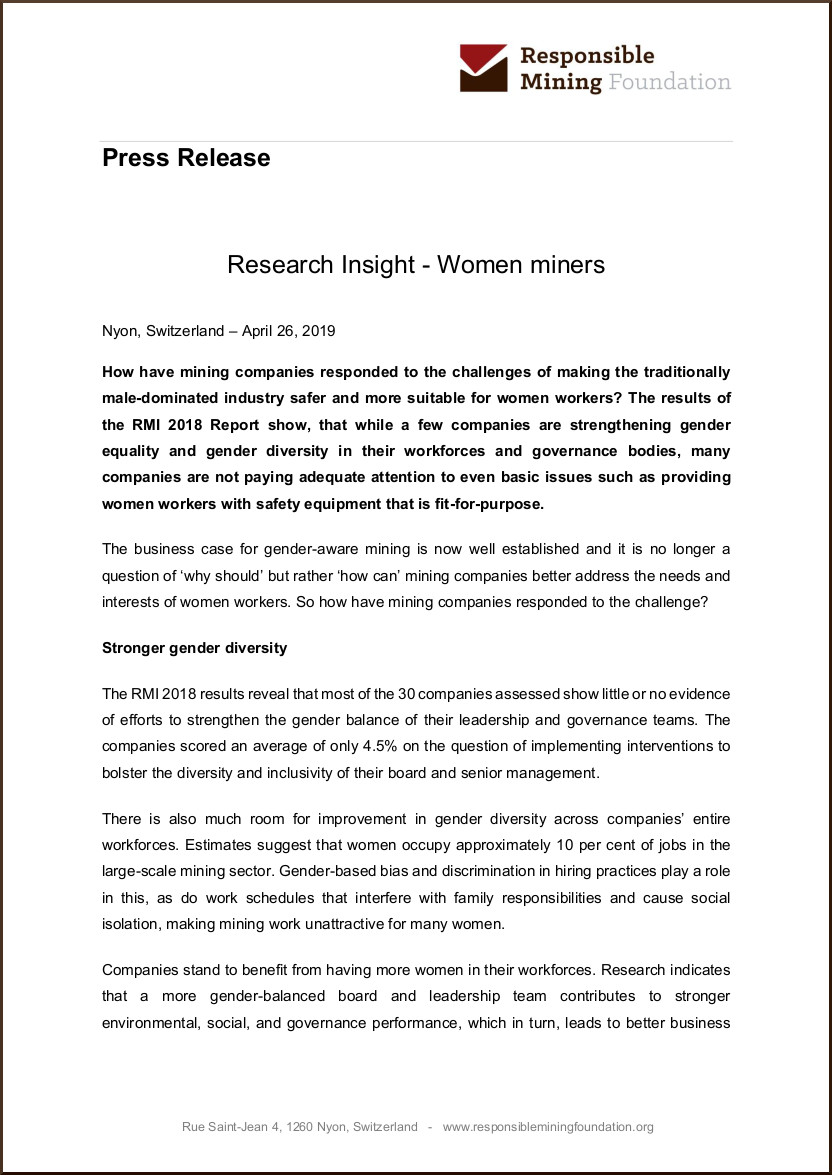Research Insight on Women Miners

|
Download the Press Release (pdf) ➥ English ➥ Español ➥ Français |
How have mining companies responded to the challenges of making the traditionally male-dominated industry safer and more suitable for women workers? The results of the RMI 2018 Report show, that while a few companies are strengthening gender equality and gender diversity in their workforces and governance bodies, many companies are not paying adequate attention to even basic issues such as providing women workers with safety equipment that is fit-for-purpose.
The business case for gender-aware mining is now well established and it is no longer a question of ‘why should’ but rather ‘how can’ mining companies better address the needs and interests of women workers. So how have mining companies responded to the challenge?
Stronger gender diversity
The RMI 2018 results reveal that most of the 30 companies assessed show little or no evidence of efforts to strengthen the gender balance of their leadership and governance teams. The companies scored an average of only 4.5% on the question of implementing interventions to bolster the diversity and inclusivity of their board and senior management.
There is also much room for improvement in gender diversity across companies’ entire workforces. Estimates suggest that women occupy approximately 10 per cent of jobs in the large-scale mining sector. Gender-based bias and discrimination in hiring practices play a role in this, as do work schedules that interfere with family responsibilities and cause social isolation, making mining work unattractive for many women.
Companies stand to benefit from having more women in their workforces. Research indicates that a more gender-balanced board and leadership team contributes to stronger environmental, social, and governance performance, which in turn, leads to better business performance. Higher female workforce participation can also raise attendance and retention rates as well as reduce organisational risks within businesses.
Better site-level safety
It is at the mine-site level where women are most vulnerable to unsafe and hostile working conditions. Basic requirements, such as fit-for-purpose goggles, helmets and other Personal Protective Equipment (PPE), or secure toilet and changing room facilities, are often lacking for women workers.
The dimly lit and confined environment of underground mines makes them particularly unsafe for women, with the heightened risk of gender-based harassment and violence. A study in Canada, for example, found that almost 40 per cent of women working in mine sites reported having experienced harassment in the last five years.
The RMI 2018 results show that over 75% of the companies assessed are unable to demonstrate that they have systems in place to ensure the provision of gender-appropriate PPE for their women workers. And while many have policies in place to prevent sexual harassment, 75% of the companies show no evidence of systematic measures to prevent harassment of women workers.
Role of other actors
Producing country governments can prohibit discriminatory labour practices and set requirements for women’s employment and gender-appropriate safety equipment in mining companies. It is no coincidence, for example, that South African and Chilean companies perform best in RMI 2018 on ensuring gender-appropriate sanitation facilities and safety equipment, as both countries have put special policy measures in place for women workers. International initiatives, such as the Women’s Rights and Mining group or the UN Working Group on Business and Human Rights, can raise global awareness of gender issues in mining and work to improve policies and practices.
Mining workers and their representatives are also making change happen. IndustriALL Global Union, an international federation of labour unions, for example, is promoting gender diversity and tackling gender-based violence in the mining sector workforce. And the international Women in Mining network is bringing gender-related mining issues to the fore.
Making mining work for women
The Responsible Mining Foundation (RMF) recognises the efforts made by a few companies to strengthen gender equality and gender diversity in their workforces and governance bodies and encourages more mining companies to adapt and adopt the good practice models already available. Such an approach would go a long way towards enabling mining companies to make their businesses more gender-equitable, more gender-inclusive and, ultimately, more successful.
Or read the Research Insight online:
https://www.responsibleminingfoundation.org/research/women-miners/
Responsible Mining Foundation
The Responsible Mining Foundation (RMF) is an independent research organisation that encourages continuous improvement in in responsible mining across the industry by developing tools and frameworks, sharing public-interest data and enabling informed and constructive engagement between mining companies and other stakeholders.
As an independent foundation, RMF does not accept funding or other contributions from the minerals and metals industry.